Python versions used and supported:
The work is part of a set of preliminary studies for Low EMittance Muon Accelerator (LEMMA) Collaboration.
Through a Monte Carlo simulation we study the kinematic features of a low emittance muon beams from e+ e- collisions at centre-of-mass energy just above the μ+ μ- production threshold corresponding to a positron beam of about 45 GeV.
At the end we obtain the hits distribution in the detector plane and the momenta distributions in the laboratory frame for (anti-)muons. Regarding of modeling we assumed a positron beam in which particles are uniform distribuited in a circle and with energies gaussian distributed. An angular smearing is also considered for each particle composing the incident beam. For the taghet we cosider a 6 cm thick Beryllium block and to obtain the hits distribution for μ+ and μ- we assume the presence of a 2 meter long, 1.7 Tesla dipole magnet placed after the target.
All the parameters set in the simulation are easily editable.
- Alberto Chimenti (University of Padova)
- Clara Eminente (University of Padova)
- Matteo Guida (University of Padova)
- Professor Marco Zanetti (University of Padova, CERN)
- Camilla Curatolo (University of Padova, INFN)
-
LEMMA, the original paper describing the positron-induced low emittance muon source, here all the relevant kinematic features of the process have been studied
-
Babayaga Monte Carlo event generator for processes at flavour factories. It is used in our simulation for the comparison of the results obtained.
-
Main theoretical source :
3.1. Michael E. Peskin, Dan V. Schroeder - An Introduction to Quantum Field Theory.
-
Doane's formula for binning histograms. Doane DP (1976) Aesthetic frequency classification

